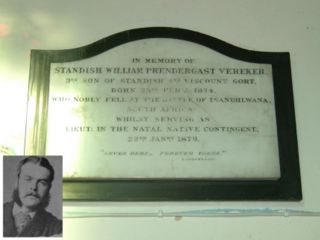|
Location
In St James's Church, East Cowes, Isle of Wight, PO32 6JT IWM War Memorials Archive Record The Memorial is not yet listed by the War Memorials Archive Historic England Listing Status St James's Church is Grade II Listed. Since the War Memorial is sited within the church, it is assumed that it is covered by the Listing. Description A marble plaque. [Memorial has not been visited or recorded by the Memorials in Isle of Wight team] |
|
|
Inscription
IN MEMORY OF STANDISH WILLIAM PRENDERGAST VEREKER, SON OF STANDISH 4TH VISCOUNT GORT. BORN 23RD FEBY. 1854, WHO NOBLY FELL AT THE BATTLE OF ISANDHLWANA, SOUTH AFRICA WHILST SERVING AS LIEUT: IN THE NATAL NATIVE CONTINGENT, 22ND JANRY. 1879. "NEVER HERE, FOREVER THERE" LONGFELLOW Further Information Standish William Prendergast Vereker was the son of Lord Standish Prendegast Vereker (later 4th Viscount Gort), and his wife the Hon. Caroline Vereker (née Gage). He was born 23 February 1854 in St Margaret's Parish, London. In 1861 Standish W P Vereker, aged 7, was with his aunt Elizabeth Gage at West Firle, Sussex. In 1871 Standish W P Vereker, aged 17, was a boarding pupil with the Rev. William Attenborough at the Vicarage, Fletching, Sussex. Standish W P Vereker matriculated from Worcester College, Oxford, 20 October 1873. Standish W P Vereker was educated at the Royal Agricultural College, Cirencester, from 1873-74. In 1881 Viscount and Viscountess Gort were at East Cowes Castle; Standish W P Vereker had died by this time. Standish W P Vereker is also commemorated by a plaque in the Chapel at the Royal Agricultural College in Cirencester.
(From 'But Burdens Shouldered' by Tim Day)
Born: 23rd Feb 1854, the son of Standish, 4th Viscount Gort and his wife Caroline. Educated: Westminster, Oxford and Cirencester. Married: Unmarried. Service: Emigrating to South Africa with the intention of setting up a farm he almost immediately joined the Frontier Light Horse, 1878, then the Natal Native Contingent, 1879. Zulu War: He was present at Isandlwana and when the camp was overrun managed to catch a stray horse which was then claimed by another. Courageously giving up his one chance of possible escape, his body was later discovered and buried on the battlefield. Died: Killed in Action, Isandlwana, 22nd January 1879. Memorials: A memorial tablet was erected to him by his parents inside the church at East Cowes. A screen has since been erected to partition the area as a robing room and access is difficult as both this area and the church are normally locked.
(From 'The South African Campaign of 1879' by J.P. Mackinnon & S.H. Shadbolt)
THE HONOURABLE STANDISH WILLIAM PRENDERGAST VEREKER Standish William Prendergast Vereker, who was killed at Isandhlwana on the 22nd of January, 1879, was the third son of the present Viscount Gort, by his marriage with Caroline Harriet, daughter of Viscount Gage. He was born on the 23rd of February, 1854, and was educated at Westminster School and Worcester College, Oxford. From Oxford he proceeded to the Royal Agricultural College at Cirencester, and subsequently spent two years studying agricultural work and collateral subjects under practical farmers, chiefly on Mr. Horner's estate at Athelhampton, near Dorchester. On the 22nd July, 1878, he embarked for South Africa, and a month later arrived at Cape Town. Finding the war with the independent tribes still in progress on the Transvaal frontier, he and some friends who had travelled with him (one of whom was Metcalfe Smith, the young militia officer, for saving whose life Major Leet received, subsequently, his Victoria Cross) proceeded by way of Natal to that district, and there joined the Frontier Light Horse, under Colonel Redvers Buller; with that force he served for the remaining weeks during which the operations against the Sekukuni were continued. On the reorganization of the army in view of the impending invasion of Zululand, Vereker received a commission in the 3rd, or Lonsdale's, Regiment of the Natal Native Contingent, a corps belonging to the Head-quarter Column, then in course of concentration on the Buffalo River. He subsequently took part in the advance of that force, in January, 1879, into the enemy's country, and was present at the storming of Sirayo's stronghold, in the Bashee Valley. He accompanied the column to Isandhlwana, and in the disastrous encounter with the enemy at that position on the 22nd - just six months from the day of his embarkation from England - closed the brief span of his life with an act of heroic and characteristic generosity. Captain Raw, of the Native Contingent, who was one of the few who survived that fatal day, and afterwards did good work against the Zulus, was fighting by his side until resistance was rendered hopeless by the slaughter of almost all our force, and the precipitous drift leading towards the Tugela (sic) offered mounted men the best chance of escape. Vereker had lost his horse, and his friend succeeded in catching one and bringing it to him. "He saw him a few seconds before the retreat," runs the record. "He got him a horse, which a native claimed, and which poor Vereker refused to deprive him of; he thus deprived himself of all chance of escape." Four months afterwards Vereker's body was found on the field of battle by Captain Viscount Downe, still unstripped, and was easily identified. At his hands it received a soldier's sepulture. Thanks to Tim Needham for photograph and further information. |
|
Page last updated : 6 January 2012 (added to website)

